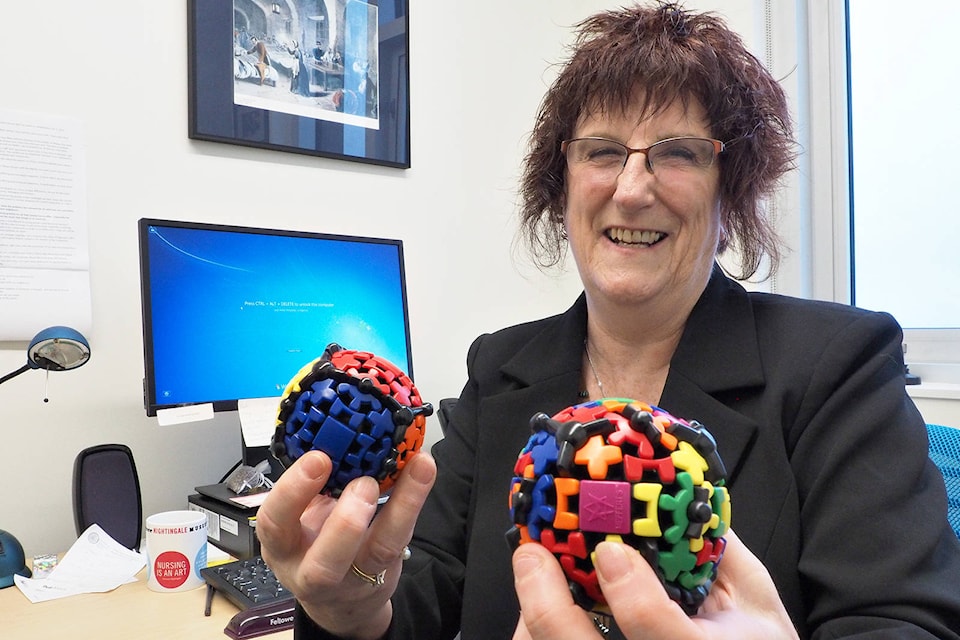Emergency first responders attending workshops on mental and emotional resilience might find themselves fidgeting with Gear Balls.
Leigh Blaney, health and human services professor at Vancouver Island University, utilizes the puzzles as part of her studies into human emotional and mental resilience and the effectiveness of resilience training on volunteer firefighters.
Compared to people who don’t work as emergency first responders, volunteer firefighters are exposed more frequently to traumatizing events and must cope with the physical, mental and emotional impacts that can arise afterward. Blaney’s research is geared toward volunteer firefighters because, of B.C.’s 14,000 firefighters, about 10,000 of those are volunteers in departments that lack the funding and resources of their full-time staffed municipal counterparts.
Blaney, with 25-plus years’ experience in critical incident stress management, has co-created a resilience education program – a series of workshops developed as part of a pilot project funded by VIU and WorkSafe B.C. – with Geoff Spriggs, former Langford Fire Rescue assistant chief, to help firefighters develop resilience before they experience traumatic incidents. Spriggs is also president of the Archipelago Critical Incident Stress Management Society, a volunteer non-profit society that provides education and intervention services to fire rescue services on Vancouver Island and the Gulf Islands.
“We keep seeing anecdotally the ability for firefighters to often bounce back and recover with health in mind, especially when they are provided good information, good leadership, and a healthy work culture to support them,” Spriggs said in an e-mail. “What is important about this research is it looks to prove and better inform the anecdotal information with good research to help tell us more about why and how it is actually working.”
Spriggs said he believes education he received early in his 25-year firefighting career on the effects of stress in his line of work “really help me keep myself, my family and my colleagues functioning well to do what we love which is support our community and help others in their difficult times.”
Blaney uses Gear Balls – puzzles that resemble spherical Rubik’s Cubes, with six coloured segments – in the workshops to help participants visualize six categories of personal resilience: relationships, personal resources, meaning-making (the ability to find some meaning in seemingly random negative experiences), culture, leadership and knowledge. Those six resilience attributes and how they relate to each person can be scored before and after attending the workshops for later comparison.
“I pull them out for my resilience-building workshops and people just disappear into them, but it was a really good, model, I thought,” Blaney said.
Gear Balls are just one of her workshop tools, but they’re effective because for each person resilience categories aren’t necessarily distinct, instead – as Blaney illustrates by twisting a Gear Ball to randomly mix its colours – the composition of resilience is unique for each individual and can reconfigure according to experiences, such as living through a traumatic event.
But negative experiences don’t necessarily translate into negative outcomes, such as developing post-traumatic stress disorder. For the majority of people, improved resilience is the most common result.
“There is this, sort of, mistaken myth, I suppose, that every bad [emergency] call is going to create a traumatic reaction for people,” Blaney said. “It doesn’t. It creates a human stress reaction for people and that feels uncomfortable and so, if we have access to resilience strategies then we can decrease that level of distress much more quickly.”
Firefighters and emergency services personnel, generally, are quite resilient, Blaney said, and mentally and physically healthy, but there is still much that isn’t understood about resilience and how we “live” resilience.
“There’s lots of work being done on those who are not so healthy and the negative outcomes of stress. What can we learn from those who are actually healthy mentally and physically?” she asked. “So that sort of spurred the interest in resilience. How do firefighters understand resilience? What is resilience for them and how do they maintain their resilience throughout the course of their career?”
Blaney’s research looks at resilience attribute scores and compares those taken before, immediately after and two months after the 2019 workshops. The findings indicate there is evidence that building resilience by teaching and practising resilience-building skills gives firefighters a better understanding of resilience as a health concept and builds on furthering their resilience overall.
VIU has provided additional funding to start a pilot project for emergency room nurses. Blaney would like to see resilience training integrated at all volunteer fire departments.
She is also working with Vancouver Island-based online game company Hypersurge and the company’s owner Robert Fell – also a volunteer firefighter – to create a video game or mobile app, based on real-life scenarios, to help make resilience training available anywhere.
READ ALSO: Wounded Warrior Run raising awareness about PTSD stops in Nanaimo
READ ALSO: B.C. first responders to get better mental health support
photos@nanaimobulletin.com
Like us on Facebook and follow us on Twitter
